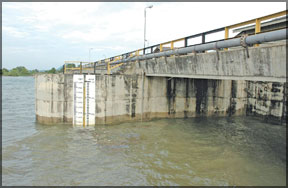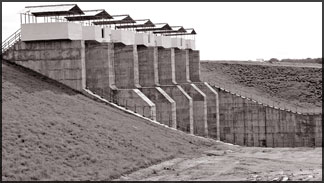Weheragala Reservoir diversion - history is re-written
Lionel WIJESIRI
“We forget that the water cycle and the life cycle are one.”
I was reminded of the above quote by Jacques Cousteau, the famous
French scientist who studied all forms of life in water, as I was
watching the 2.030 metres long Weheragala Dam built across the Menik
Ganga in the Yala National Park. For once, Cousteau was proved wrong.
Our great King Parakramabahu did not forget the value of water when he
proclaimed that not a single drop of water should flow to the sea
without utilization. The Weheragala Reservoir project, per se, a
brainchild of President Mahinda Rajapaksa, is based on this premise.
This reservoir has been built in keeping with the aspirations of King
Parakramabahu as part of ‘Mahinda Chintanaya’ concept.
|

Lunugamvehera reservoir. Courtesy: Media Unit, Irrigation
Department |
Mahinda Chintanaya does not stop there. In addition to Weheragala
project, there are six other schemes to complete shortly. The Deduru Oya
and Rambukan Oya projects are already started. The uniqueness of all
these projects is that neither foreign aid nor foreign personnel will be
utilized.
Challenges
Each year, a surplus of water from the Menik Ganga, uncontrollably
flows into the sea, inundating and causing much havoc and devastation to
life and property in transit. This vast, unutilized water resource will
be trapped by a dam of 2030 metres long and collected into Weheragala
Reservoir with a capacity of 75 million cubic-metres. Water from this
reservoir will be conveyed to Lunugamvehera reservoir through an
environmentally friendly shallow contour canal of 23 kms and it would
carry a capacity of 65 million cubic metres of water annually.
Lunugamvehera is a multi-purpose reservoir, which was constructed in
1987 by damming the Kirindi Oya under the Kirindi Oya Irrigation and
Settlement Project.
I met Eng. W.M. Gunadasa, Chief Project Engineer, at the site of the
dam. He was involved in the project from the start and talked about the
various challenges he and his team of workers had to face to make the
project a reality. He said a number of benefits will flow down to the
people once the project is commissioned. The scheme will develop an area
of 5700 hectares, and uplift the livelihoods of 5,600 farming families
engaged in paddy and minor crop cultivation. Four thousand one hundred
hectares of land would be brought under paddy cultivation. The farming
community in Weerawila, Debarawewa, Thanamalwila and Pannegamuwa will
have the ability of cultivating both the Yala and Maha Kanna. Therefore
the present risk of cultivation of the 6,000 hectares of land extent in
the new area under the Lunugamvehera reservoir would be minimized. There
are several minor tanks in the vicinity of Kataragama. All these tanks
do not hold water for successful cultivation of both seasons and this
diversion will ensure water for these tanks during both seasons to
stabilize cultivation.
|

Lunugamvehera reservoir. Courtesy: Media Unit, Irrigation
Department |
One of the major problems at the Kataragama area is the supply of
water for drinking and bathing during the festival season when Menik
Ganga goes dry. During the months of July and August there is hardly any
flow in Menik Ganga at Kataragama and the National Water Supply and
Drainage Board finds it difficult to supply water even for drinking. The
Weheragala diversion ensures continuous flow throughout the year and
this would benefit not only devotees and residents of Kataragama, but
fauna and flora along Menik Ganga between Kataragama and Yala.
Local expertise
The utilization of solely indigenous know-how, expertise and
resources in the project, is another unique and salient feature to be
noted. Similar projects in the past have been undertaken by foreign
contractors at comparatively high costs, resulting in the loss of
valuable foreign exchange to the country. The budgeted cost of the
project which started in 2006 was around Rs. 2900 million whereas it is
now estimated under Rs. 2000 million by completion.
The project has generated around 750 job opportunities for the
villagers, in the neighbouring areas of Kataragama, Hambantota,
Weerawilla, Tanamalwilla and Tissamaharama. An allocation of Rs.275
million has been set aside as wages for the whole project. More
engineers, too, have been recruited.
The project took slightly over two years to complete. Considered in
the perspective of its local funding and skills, it was a good
achievement. I asked Director General of Irrigation, Eng. H.P.S.
Somasiri what factors accounted for the success.
“Total commitment from top to bottom. That is the secret. Minister,
Chamal Rajapaksa was right behind us throughout the project and ensured
funds were available without interruption. Coupled with that fact and a
willing team of workers made us complete the project within the targeted
deadline”. Somasiri also had a word of gratitude to Eng. A.D.S.
Gunawardena, ex-Secretary of the Ministry of Irrigation, for the hard
work he had put in to move the project off the ground and maintain the
momentum at steady speed.
Eng. Ivan de Silva, the present Secretary of the Ministry of
Irrigation said that the main objective of the Government’s irrigation
projects is not only to supply the farming community with sufficient
water for their cultivation but also to assist them to grasp and
implement the high-tech agricultural systems such as drip system of
irrigation. For example, drip irrigation has proved to be a success in
terms of increased yield in a wide range of crop including paddy.
Its ability of small and frequent irrigation applications have
created interest because of decreased water requirements, increased
production and better quality produce.
When asked about local expertise, Eng. de Silva said, “Our engineers
have developed considerable expertise in the irrigation sector and have
proven they can match the international standards. As a matter of
Government policy, as far as possible, in future projects we will seek
and use local talent.”
As I turned back from the site, a subtle thought crossed my mind.
Throughout the history we were deeply rooted in an agriculture based
economy. And, still we are! Modern irrigation system networks will make
a substantive contribution to the development of an efficient
agriculture sector and take us back to the glory of King Parakramabahu
era. That is the gist of the ‘Mahinda Chintanaya’ concept.
Weheragala reservoir project is just one giant step towards the
realization of that concept. |



